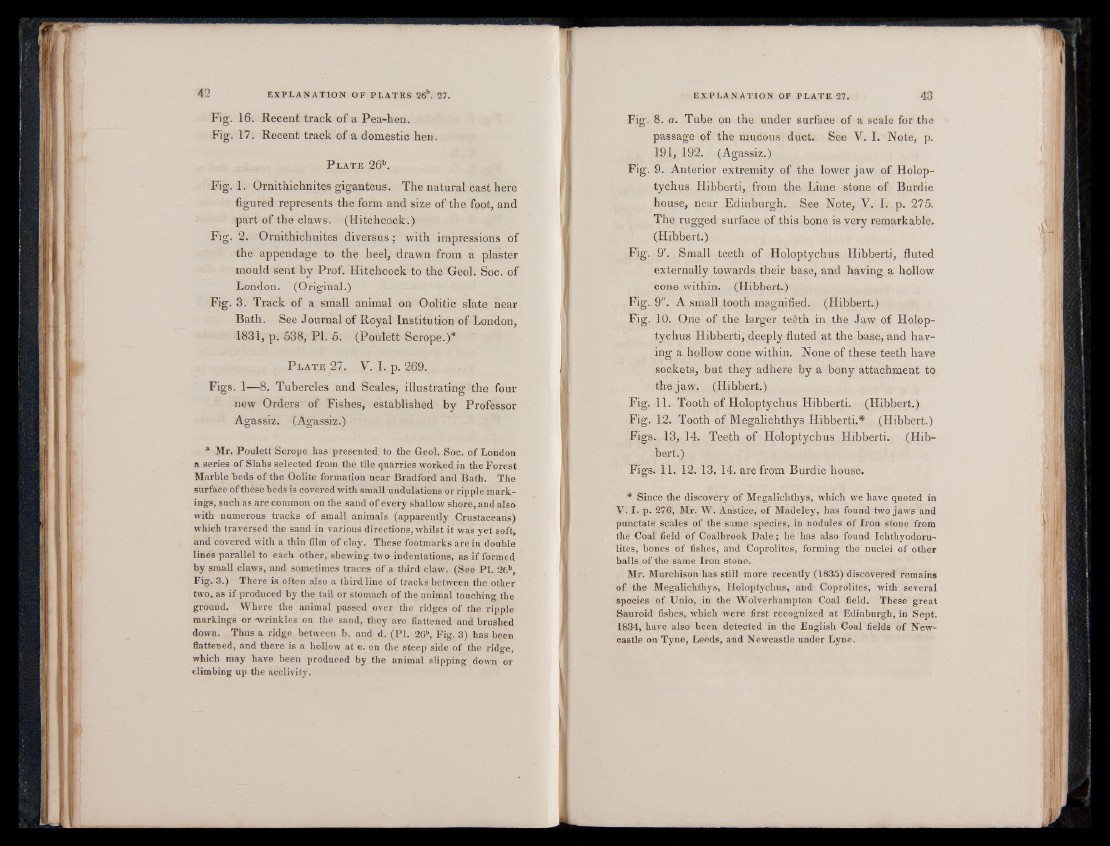
Fig. 16. Recent track of a Pea-hen.
Fig. 17. Recent track of a domestic hen.
P late 26b.
Fig. 1. Ornithichnites giganteus. The natural cast here
figured represents the form and size of the foot, and
part of the claws. (Hitchcock.)
Fig. 2. Ornithichnites diversus; with impressions of
the appendage to the heel, drawn from a plaster
mould sent by Prof. Hitchcock to the Geol. Soc. of
London. (Original.)
Fig. 3. Track of a small animal on Oolitic slate near
Bath. See Journal of Royal Institution of London,
1831, p. 538, PI. 5. (Poulett Scrope.)*
P late 27. V. I. p. 269.
Figs. 1—8. Tubercles and Scales, illustrating the four
new Orders of Fishes, established by Professor
Agassiz. (Agassiz.)
* Mr. Poulett Scrope has presented to the Geol. Soc. of London
a series of Slabs selected from the tile quarries worked in the Forest
Marble beds of the Oolite formation near Bradford and Bath. The
surface of these beds is covered with small undulations or ripple markings,
such as are common on the sand of every shallow shore, and also
with numerous tracks of small animals (apparently Crustaceans)
which traversed the sand in various directions, whilst it was yet soft,
and covered with a thin film of clay. These footmarks are in double
lines parallel to each other, shewing two indentations, as if formed
by small claws, and sometimes traces of a third claw. (See PI. 26b,
Fig. 3.) There is often also a third line of tracks between the other
two, as if produced by the tail or stomach of the animal touching the
ground. Where the animal passed over the ridges of the ripple
markings or -wrinkles on the sand, they are flattened and brushed
down. Thus a ridge between b. and d. (PI. 26b, Fig. 3) has been
flattened, and there is a hollow at e. on the steep side of the ridge,
which may have been produced by the animal slipping down or
climbing up the acclivity.
Fig. 8. a. Tube on the under surface of a scale for the
passage of the mucous duct. See V. I. Note, p.
191, 192. (Agassiz.)
Fig. 9. Anterior extremity of the lower jaw of Holop-
tychus Hibberti, from the Lime stone of Burdie
house, near Edinburgh. See Note, V. I. p. 275.
The rugged surface of this bone is very remarkable.
(Hibbert.)
Fig. 9'. Small teeth of Holoptychus Hibberti, fluted
externally towards their base, and having a hollow
cone within. (Hibbert.)
Fig. 9". A small tooth magnified. (Hibbert.)
Fig. 10. One of the larger te§th in the Jaw of Holoptychus
Hibberti, deeply fluted at the base, and having
a hollow cone within. None of these teeth have
sockets, but they adhere by a bony attachment to
the jaw. (Hibbert.)
Fig. 11. Tooth of Holoptychus Hibberti. (Hibbert.)
Fig. 12. Tooth of Megalichthys Hibberti.* (Hibbert.)
Figs. 13, 14. Teeth of Holoptychus Hibberti. (Hibbert.)
Figs. 11. 12. 13. 14. are from Burdie house.
* Since the discovery of Megalichthys, which we have quoted in
V. I. p. 276, Mr. W. Anstice, of Madeley, has found two jaws and
punctate scales of the same species, in nodules of Iron stone from
the Coal field of Coalbrook Dale; he has also found Ichthyodoru-
lites, bones of fishes, and Coprolites, forming the nuclei of other
balls of the same Iron stone.
Mr. Murchison has still more recently (1835) discovered remains
of the Megalichthys, Holoptychus, and Coprolites, with several
species of Unio, in the Wolverhampton Coal field. These great
Sauroid fishes, which were first recognized at Edinburgh, in Sept.
1834, have also been detected in the English Coal fields of Newcastle
on Tyne, Leeds, and Newcastle under Lyne.